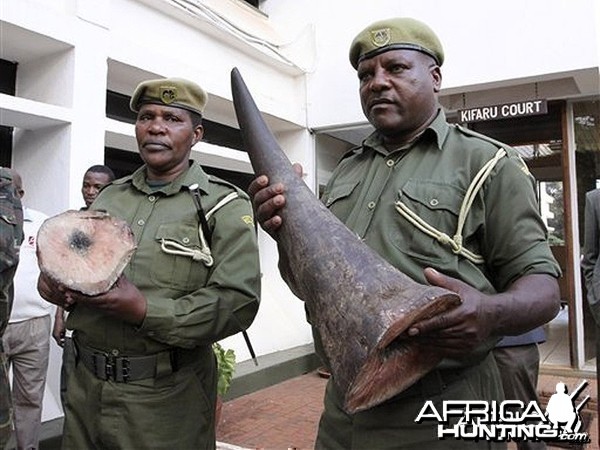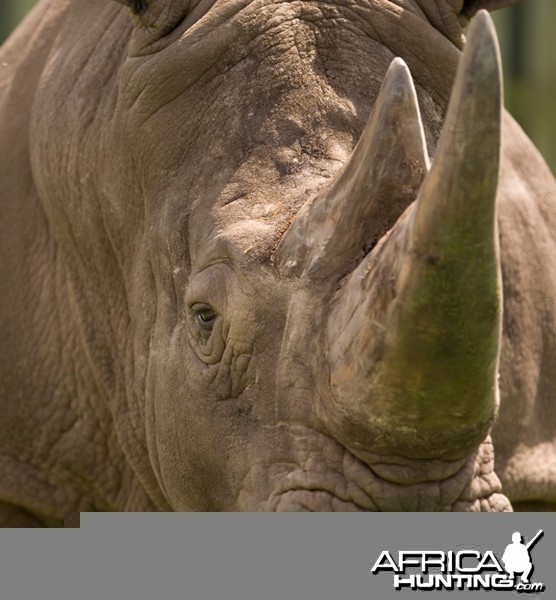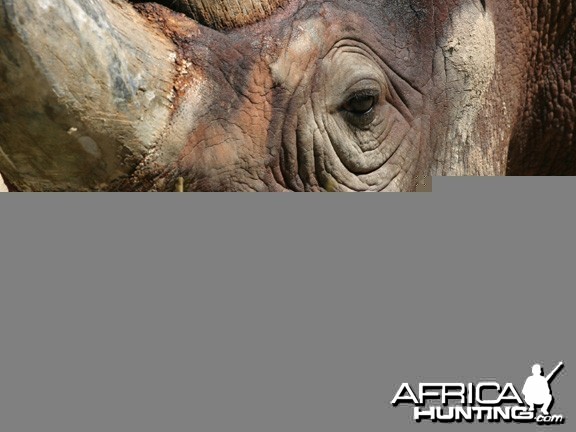Frequently Asked Questions: Rhino Dehorning
Frequently Asked Questions: Rhino Dehorning
Endangered Wildlife Trust’s Rhino Security Project (
www.ewt.org.za)
The Endangered Wildlife Trust (EWT), in recognizing a dire need to urgently address the rapidly escalating problem of rhino poaching in South Africa, has developed a project to strengthen the security of rhino in South Africa. The Rhino Security Project will address rhino security concerns on privately owned game farms as well as in formally protected areas; improve communication between rhino owners and the relevant government officials; support improved investigations into rhino poaching incidences; work with relevant bodies to identify causes and drivers of the trade in rhino horn; and enhance current knowledge on the demographics of rhinos in situ in collaboration with other existing initiatives. Pursuant to the launch of the EWT’s Rhino Security Project and in response to the recent spate of rhino poaching in South Africa, many individuals have suggested that a simple solution to this complex problem is to dehorn all rhinos. The following question and answers aims to give you some facts about rhino dehorning as a conservation tool.
What is the composition of rhino horn?
The conventional belief is that rhino horn is simply a clump of compressed or modified hair. Researchers at the University of Ohio in the USA have used computerized tomography, better known as a CT scan, to show that horns are comprised of calcium, melanin and keratin, and are actually similar in structure to horse hooves, turtle beaks, and cockatoo bills.
What is rhino horn used for in the eastern market place?
Rhino horn has several uses including: an alleged remedy against fever, gout, rheumatism, and many other non life threatening ailments, an alleged cure against aggressive cancer, ornamental use, an aphrodisiac (this is denied by the Chinese themselves), and Yambiya handles in Yemen.
Does rhino horn actually have any medicinal value?
In China, rhino horn has been used for Traditional Chinese Medicine (TCM) since 2000 BC and therefore belief in its medicinal properties is firmly entrenched. Modern science has been unable to prove definitively that rhino horn has real medicinal properties. Furthermore, claims that rhino horn has any medicinal value must be weighed up against the use of other more effective, sustainable and ethical products.
Can rhino horn be legally sold on the international market?
The international trade in rhino horn was banned in 1976 by signatories to the Convention on the International Trade in Endangered Species (CITES). In 1993 the Chinese government also banned the use of rhino horn, or any other parts from endangered species, in Traditional Chinese Medicine.
Can rhino horn be sold in South Africa?
On 13th February 2009, the Minister of Environmental Affairs and Tourism, published a national moratorium on the trade of individual rhinoceros horns and any derivatives or products of the horns within South Africa, in terms of Section 57(2) of the National Environmental Management: Biodiversity Act, 10 of 2004 (NEMBA). However, rhino horn may be traded as part of a trophy obtained during a legal trophy hunt.
What are the legal implications of dehorning rhino?
In terms of the Threatened or Protected Species Regulations of 2007 (TOPS) drafted in terms of NEMBA no person may, without being in possession of a valid permit: hunt, capture, kill, convey, import, export, keep live rhino in captivity, or possess a rhino horn.
Is dehorning an effective counter‐poaching measure?
Poachers are prepared to remove any vestige of horns, including the small growth nubs on rhino calves, and therefore dehorning is unlikely to be an adequate deterrent. Dehorning will only reduce the temptation to potential poachers if the re‐growth is cut regularly to ensure that the horn mass remains very low. Zimbabwe reported that their dehorning effort was successful, but only if used in conjunction with traditional counter‐ and anti‐poaching measures such as regular patrols and population monitoring. The principle should always be to “maximize risk for the poacher and minimize his reward”.
What are the arguments IN FAVOR of a legal, regulated trade in rhino horn?
It has been argued that flooding the market with horns harvested from dehorned rhinos would reduce incentives for poachers. Several arguments have been put forward supporting the legal trade in rhino horn:
• Rhino horn can be obtained without killing the animal and it therefore represents a renewable resource.
• Lifting the ban on trade in rhino horn would allow range states to manage their rhino populations and generate funds that could be ploughed back into conservation, surveillance and anti-poaching activities.
• Considerable quantities of confiscated horn are now building up in warehouses, and these could be used to generate conservation funds (but see below).
• A reduction in the global price of rhino horn would reduce the incentive for poachers.
• Selling rhino horn legally would produce a much greater return per unit area than current activities in many conservation areas.
What are the arguments AGAINST a legal, regulated trade in rhino horn?
Legalizing the trade in rhino horn is a highly controversial and risky approach and some strong arguments have been made against lifting the ban:
• Even under a sustainable dehorning programme there may simply not be enough rhinos to meet the demand for rhino horn. In this case poachers would continue to kill rhinos from areas not practicing “rhino farming”.
• The relationship between the volumes of horn traded and the demands of world markets is not well understood and there is a risk that it is not possible to influence global prices.
• CITES (the Convention on International Trade in Endangered Species) demands proof of legal acquisition of rhino horn.
• Current stockpiles include horns of unknown origin, including those seized by the government agencies during enforcement activities, which can never be sold.
• Even with careful regulation, the establishment of legal trade routes could provide a front for trade from illegally obtained sources, as it may be difficult to establish the origins of the horn.
• Many governments do not have adequate resources to protect animals from illegal poaching, let alone to police a legal trade.
• The process of dehorning itself is a threat to individuals as tranquilization has inherent risks.
What needs to be in place to lift the ban on trade in rhino horn?
Ultimately, the decision to lift the ban on trade in rhino horn is not one that can be made by individual range states. Any decision to lift the ban on rhino horn trading would have to come from the influential members of CITES. A non‐detriment finding would also\ be needed for South Africa, to demonstrate to CITES that the trade in rhino horn would not constitute a risk to our populations.
Can dehorning be achieved without injuring the rhino?
A rhino’s horn is not fixed to the skull of the animal but is almost an extension of the skin and is similar to a person’s fingernails. Horns should not be cut too close to the skull as this can cause injury to the animal, infection can set in and the animal can die. Horns must be removed by skilled veterinarians.
How does dehorning effect rhino social behavior?
The Zimbabwean authorities embarked on a fairly extensive dehorning exercise in the past and they emphatically state that they could not detect any negative effect on the social behavior of the dehorned rhinos. However more research is needed into this issue.
Does a rhino’s horn grow again after dehorning?
Studies in Zimbabwe have shown that rhino horns grow at a rate of up to 12 cm each year, and that horns of females grow slightly faster than those of males. Horns can therefore grow back to their original length and shape in time, but only if the growth plate of the horn is not damaged.
What are the additional risks involved in dehorning?
The biggest risk to the rhino is associated with the immobilization process, which is inherently dangerous and can be fatal. The biggest risk to the rhino owner is being in possession of the very commodity that poachers are after. Keeping of horns, especially in large numbers, exposes the owner to being the victim of potential criminal activity. A number of armed robberies involving the theft of entire stockpiles have already occurred in South Africa. The targets included museums, national parks, taxidermist studios as well as private individuals.
What should happen with the horns after dehorning?
A valid permit is required to possess rhino horn. Horns must be measured, weighed, micro‐chipped and registered by a conservation official. The onus is on the owner to keep the horn safe.
What are the costs involved in dehorning a rhino?
Costs associated with dehorning include veterinary expenses (time, drugs), labor and possible air support – particularly in dense habitats. Depending on the circumstances, a dehorning exercise can cost in excess of R8, 000 per animal, but will be proportionally reduced if more animals are dehorned during the same operation. Currently these costs are not recoverable as the horns, once removed, may not be legally sold.
Can a rhino owner make use of “green hunting” to recover the costs of dehorning?
Green hunting is a practice where a third party pays for the opportunity to dart (immobilize) a rhino and to have pictures taken with the animal. The drugs used for immobilization may by law only be prescribed to a qualified veterinarian registered with the South African Veterinary Council. The South African Veterinary Council has declared green hunting an unethical procedure, which means that veterinarians may no longer take part in or facilitate green hunts. The Department of Environmental Affairs and Tourism will no longer issue permits for green hunts and any person who takes part in such activity will be committing an offense. Veterinarians who are involved will be summoned before the South African Veterinary Council and may lose their license.
Will a dehorned rhino still appeal to eco‐tourists?
It has been proposed that tourists would not be happy to see horn‐less rhinos, however there have been no studies to date that have investigated the effect of dehorning on tourist preferences. If the reasons for dehorning are properly communicated it is possible that concerns about dehorned rhinos could be overcome.
What effect will dehorning have on the trophy hunting of rhino?
Trophy hunters are usually after the most prestigious trophy – the biggest or longest horn. Wide‐spread and large‐scale dehorning might therefore have negative impacts on the hunting industry which has been one of the incentives for the private sector to become involved in rhino conservation.




